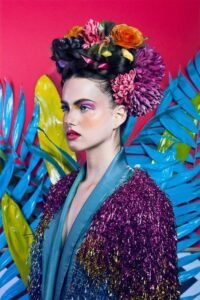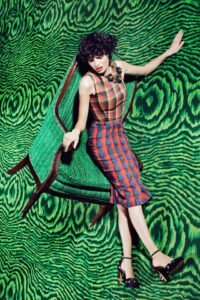Editorial fashion photography is a dynamic and influential branch of the fashion industry, serving as a powerful medium that merges art, style, and storytelling. This genre of photography goes beyond showcasing clothes and accessories; it creates compelling narratives and evokes emotions, often reflecting cultural, social, and personal themes. Editorial fashion photography can be seen in high-end magazines, online platforms, and campaigns, making it a significant aspect of visual culture.
The Essence of Editorial Fashion Photography
At its core, editorial fashion photography is about telling a story. Unlike commercial fashion photography, which focuses on selling a product, editorial fashion photography aims to engage the viewer through a conceptual approach. Each shoot is meticulously planned to convey a specific message or theme, utilizing fashion as a vehicle for artistic expression.

The essence of editorial fashion photography lies in its ability to evoke emotions and spark imagination. It’s not just about the clothes; it’s about the narrative behind them. The photographer collaborates with stylists, models, makeup artists, and other creatives to construct a cohesive story. This collaborative effort ensures that every element, from lighting to location, contributes to the overall vision.
Historical Evolution
Editorial fashion photography has evolved significantly over the decades. In the early 20th century, fashion photography was primarily focused on showcasing garments in a straightforward manner. However, the 1920s and 1930s saw a shift towards more artistic and experimental approaches, influenced by movements like Surrealism and Art Deco. Photographers like Edward Steichen and George Hoyningen-Huene were pioneers in blending fashion with fine art.
The post-war era brought further innovation, with photographers like Richard Avedon and Irving Penn pushing the boundaries of fashion photography. Avedon’s dynamic and emotive portraits and Penn’s minimalist yet powerful compositions set new standards for the industry. The 1960s and 1970s saw the rise of iconic photographers such as Helmut Newton and Guy Bourdin, who introduced provocative and edgy aesthetics, challenging societal norms and expectations.
In contemporary times, editorial fashion photography continues to evolve, embracing digital technology and diverse perspectives. Photographers like Steven Meisel, Mario Testino, and Tim Walker are renowned for their imaginative and groundbreaking work, each bringing a unique vision to the world of fashion.
The Creative Process
The creative process in editorial fashion photography involves several stages, each crucial in bringing the vision to life.
- Concept Development: The first step is developing a concept or theme. This could be inspired by various sources, such as literature, art, cinema, or current events. The concept serves as the foundation for the entire shoot, guiding decisions on location, styling, and mood.
- Team Collaboration: A successful editorial shoot relies on a skilled team. The photographer collaborates with art directors, stylists, hair and makeup artists, models, and set designers. Each member brings their expertise to the table, ensuring that every detail aligns with the overarching vision.
- Pre-Production Planning: Pre-production involves meticulous planning and preparation. This includes scouting locations, selecting wardrobe and accessories, and finalizing the shoot schedule. Mood boards and shot lists are often created to provide a visual reference and ensure that everyone is on the same page.
- Execution: On the day of the shoot, the photographer directs the team, capturing the essence of the concept through their lens. This stage requires creativity, technical skill, and adaptability, as unforeseen challenges may arise. The goal is to translate the vision into compelling images that resonate with the audience.
- Post-Production: After the shoot, post-production involves editing and retouching the images. This process enhances the final photographs, ensuring that they meet the desired aesthetic and quality. The photographer works closely with retouchers to maintain the integrity of the original vision while refining the details.
Influence on Culture and Society
Editorial fashion photography holds significant influence over culture and society. It shapes public perception of beauty, style, and identity, often reflecting and challenging societal norms. Through editorial spreads, photographers can address important issues such as gender, race, and body image, fostering conversations and promoting inclusivity.
For instance, in recent years, there has been a growing emphasis on diversity and representation in fashion photography. Publications and brands are increasingly featuring models of different ethnicities, body types, and genders, challenging traditional standards of beauty. Photographers like Tyler Mitchell and Petra Collins have gained acclaim for their work that celebrates diversity and authenticity, pushing the industry towards a more inclusive future.
Moreover, editorial fashion photography often intersects with other art forms, creating a rich tapestry of visual culture. Collaborations with artists, designers, and filmmakers result in innovative and thought-provoking imagery that transcends the boundaries of fashion.
The Future of Editorial Fashion Photography
The future of editorial fashion photography is poised for continued evolution and innovation. With advancements in technology, photographers have access to new tools and techniques, expanding the possibilities for creative expression. Virtual and augmented reality, for example, are opening up new dimensions for immersive and interactive fashion experiences.

Additionally, the rise of social media and digital platforms has democratized the industry, allowing emerging photographers to showcase their work and gain recognition. This shift has also led to a more dynamic and fast-paced environment, where trends and ideas can spread rapidly and influence global audiences.
Sustainability is another crucial aspect shaping the future of fashion photography. As the industry grapples with environmental concerns, there is a growing emphasis on ethical practices and sustainable production. Photographers and brands are exploring ways to reduce their ecological footprint, from using eco-friendly materials to minimizing waste during shoots.
Conclusion
Editorial fashion photography is a captivating and influential art form that transcends the mere depiction of clothing. It is a powerful medium for storytelling, cultural reflection, and creative expression. As it continues to evolve, this genre of photography will undoubtedly play a vital role in shaping the future of fashion and visual culture, inspiring and challenging audiences around the world.



